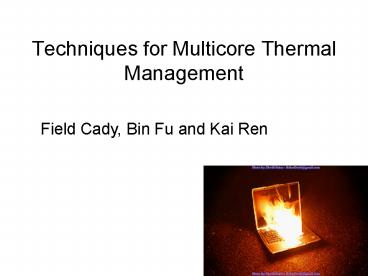Techniques for Multicore Thermal Management - PowerPoint PPT Presentation
1 / 23
Title:
Techniques for Multicore Thermal Management
Description:
PowerPoint Presentation Author: bernie Last ... 9 Migration Policies Summary & Conclusion DVFS Challenge DFVS Open-Loop Control Using Feedback (Close-loop) ... – PowerPoint PPT presentation
Number of Views:102
Avg rating:3.0/5.0
Title: Techniques for Multicore Thermal Management
1
Techniques for Multicore Thermal Management
Field Cady, Bin Fu and Kai Ren
2
Techniques for Multicore Thermal Management
- Overview and comparison of techniques
- Plus determining the critical thread
- DVFS details
- Thread movement
3
Taxonomy
- Stop Go vs DVFS
- Stop Go suspend core operation for 30
millisecs when temperature above threshold - DVFS dynamic voltage and frequency scaling,
from control theory - Distributed vs Global
- Apply above to all cores or individually
- Performance asymmetry different demands on
different cores
4
Taxonomy (cont.)
- Migration
- Moving threads between cores
- Timescale on order of a millisecond, much slower
than DVFS - Migration is outer loop or control, riding on
top of DVFS or Stop-Go - Migrate critical thread
- Measure criticality with heat sensor
- Or with cache misses as a proxy
5
Aside Criticality
- In separate paper, Abhishek et. al. defines
critical as slowest thread - If we know which is critical
- Task stealing from critical thread
- Guide DVFS to prefer critical thread
- Explored proxies
- 13-32 performance boost in task stealing on
32-core machine
6
Criticality (cont.)
- Cache misses an excellent proxy
7
Donald and Martonosi comparison of techniques
- Goal maximize performance subject to
temperature constraint - Measure performance in BIPS and duty cycle,
i.e. useful time, scaled for DVFS frequency - Run on SPEC benchmarks
- Simulated 4-core processor
8
Results
- All normalized to distributed Stop-Go
9
- Stop-Go was terrible!
- Why didnt they try with lower frequency?
- Was 30 milliseconds the right time to stop?
- They subsequently focus solely on DVFS, even
though the hardware is trickier
10
Migration Policies
11
Summary Conclusion
- DVFS far superior to Stop-Go
- Distributed control helps, esp. for Stop-Go
- Migration helps for Stop-Go
- Counter and Sensor-based migration comparable
12
DVFS
- Dynamic voltage and frequency scaling (per core).
- Dynamic voltage scaling is a power management
technique in computer architecture, where the
voltage used in a component is increased or
decreased - Dynamic frequency scaling (also known as CPU
throttling) is a technique in computer
architecture where a processor is run at a
less-than-maximum frequency in order to conserve
power.
13
Challenge
- Multiple cores may need to be manipulated
simultaneously to control both power and
temperature for a CMP chip. Require a
Multi-Input-Multi-Output (MIMO) control - Application software is always designed for
single-core processors. Power shifting needed. - Heterogeneous cores
- Workload of a CMP processor is unpredictable at
design time and may vary significantly at runtime
14
DFVS
15
Open-Loop Control
- P(k1) P (k) A ? f(k)
16
Using Feedback (Close-loop)
- Dynamically change matrix A.
17
(No Transcript)
18
Thread Motion Fine-Grained Power Management for
Multi-Core Systems
19
Motivation
- Limitations of DVFS
- Coarse grained
- Initiated by OS in milliseconds
- Voltage transition delay 10 microseconds
- Too slow to respond fine variations in program
behavior (Cache miss nanoseconds) - Per-core DVFS with multiple VF settings
- High cost of off-chip regulators
- Bad scalability with a large number of cores
20
Thread Motion
- Idea of Thread Motion
- Moving threads between cores with two VF domains
- Threads experience virtually continuous Voltage
21
Thread Motion
- TM Manager
- A separate embedded microcontroller running TM
algorithm - Effective IPC
- maintain a table of IPC for each application
- high IPC compute-intensive
- low IPC cache miss, memory access latency
22
Thread Motion Algorithm
- Movement Policy
- Assign a thread in a compute-intensive phase to a
high VF core - Intra-cluster movement considered first
- Trigger point
- TM-interval fixed intervals 200 cycles
- Miss-driven move a cache-missed thread
23
Thread Motion
Better Quality































